


Commue3D was a Japanese virtual chat client launched on December 18, 2000 by So-net, an Internet Service Provider operated by Sony Network Communications Inc, a wholly owned subsidiary of Sony.
It was a relatively standard room-based chat client. Users could visit any of the several official rooms or join ones hosted by other Commue3D users, and socially interact with one another using customizable avatars.
Commue3D was discontinued on October 30, 2002, barely two years after its release, likely due to a lack of interest and/or a failure to profit from the service.


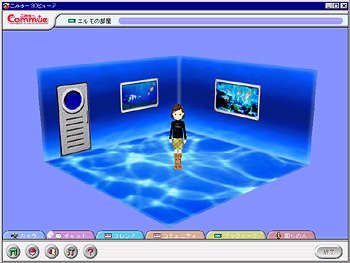
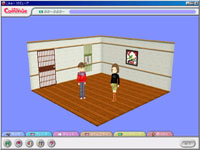
All Commue3D users could have their own personal room, which they could customize the appearance of & lock to restrict public entry.
The maximum number of users that could be in a user room at the same time (including the owner) was 3.
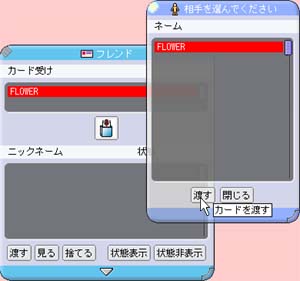
Commue3D users could hand eachother "friend cards", acting like business cards that players could choose to keep saved in their friends list. This was functionally identical to most friend systems in other games and chat clients, allowing friends to send eachother private messages, see what room they are currently in, and visit them at any time.
The maximum number of friend cards a user could hold was 10.
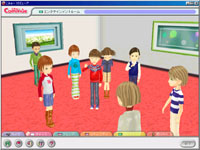
Using the website, Commue3D users could also set up "communities" and community rooms - Owners of these communities could issue membership cards and manage a web-based bulletin board, which they could set to be public or private.
Other community features included polls and calendars for community events.
The maximum number of users that could be in a community room at the same time (including the owner) was 20.
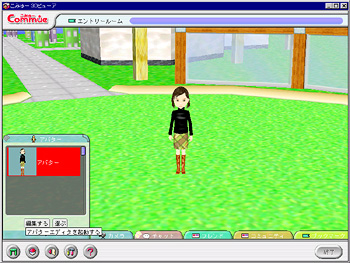

The rooms themselves appear to have been incredibly simple. Save for the rounded walls and modeled archway of the Entry Room shown above, almost all screenshots of Commue3D depict empty square rooms with only a different set of textures setting them apart from one another.
The only other decorative 3D object seen in any of the surviving screenshots of Commue3D appears to be a potted plant, which would be visible in the Avatar Editor.
The editor requires a connection to the Commue3D server through a valid Commue3D account, just like the client itself.
This is because the editor has to connect to the (now defunct) server to download assets for use in avatar customization. The editor would naturally also upload the user's avatar to the server so that it would display properly to other Commue3D users.
While some files for the basic default areas are included in the installer, there is little to no avatar data present by default. A separate "Parts Package" was available for download as well.
Users could modify their avatar's hair, face, top, bottom, and shoes.
The Commue3D website listed several "recommended rooms", each devoted to a specific topic.
The following showed up on the website throughout the first few years of Commue3D's lifespan:
- Beginners Room
Where new users could get advice on how to "play" Commue3D - Entertainment Room
For discussing music, movies, anime, and games - Sports Room
- Travel Room
For discussing domestic / overseas travel, hot springs, and amusement parks - Lifestyle Room
For discussing life, work, romance, childcare, and housing - PC / Internet Room
There was also a room browser on the Commue3D website that would allow users to find different user-made rooms, be they community rooms or public personal rooms. Rooms were listed by their name, their owner's name, and a comment describing the room. Official rooms were listed as being owned by the name of the room itself.
"ENTER" links shown underneath these rooms on the website could be clicked to take you to that room in Commue3D.

Several "campaigns" ran during Commue3D's lifespan in which users could win certain prizes, such as unique avatar parts given to users who registered during a certain timeframe.
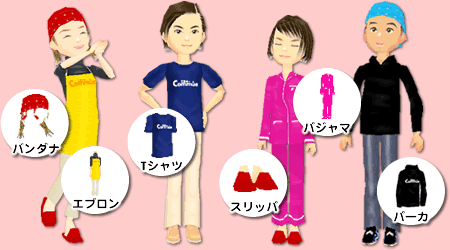
There were also plans to have users pay real money for certain features, such as a "friend card holder" and an "avatar holder". Presumably these would extend the limit of friends/avatars you could have saved at once.



It is unclear if these services were ever implemented until Commue3D's termination, as all archived versions of the website display these paid services as "planned", both on the Services page as well as in the Q&A section.
Downloads
- cmchecker.exe
Checks to see if your computer is capable of running the version of DirectX used by Commue3D 2.0. (A version of this checker software existed for Macintosh as well, though that file could not be found) - glchecker.exe
Checks to see if your computer is capable of running the OpenGL 3D Library used by Commue3D. - CmSetupDx.exe
Commue3D Installer. Sets up the Viewer/Client & the Avatar Editor. - CmSetupDx_2_0.exe
The above, but for Commue3D 2.0. - PartsPackage.exe
A set of avatar parts. - PartsPackage0001.exe
A "Special Parts Package", only available to users who registered by the end date (2/4) of the User Registration Campaign period in January and February of 2001. - SnapShotPackage1.exe
Added the ability to take a picture of your avatar and save it to a file in your avatar editor. - CmSetupMac_2_0_6.smi.bin
Commue3D Installer. Presumably sets up the Viewer/Client & the Avatar Editor. - PartsPackage.smi.bin
The above PartsPackage file, but for Macintosh users. - PartsPackage0001.smi.bin
The above PartsPackage0001 file, but for Macintosh users. - SnapShotPackage.smi.bin
The above SnapShotPackage file, but for Macintosh users.
Windows
Mac
A Macintosh version of Commue3D was released in beta on the downloads page some time around 2001.Though this version's Beta and 1.0 releases were not archived, the 2.0 release was!
Commue3D could be downloaded from Commue.com, which itself was embedded into the So-net website.